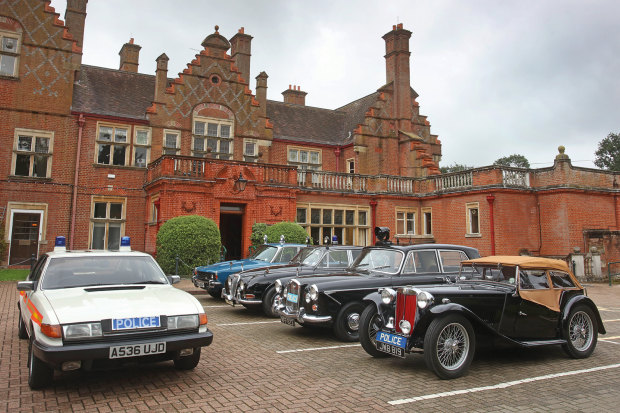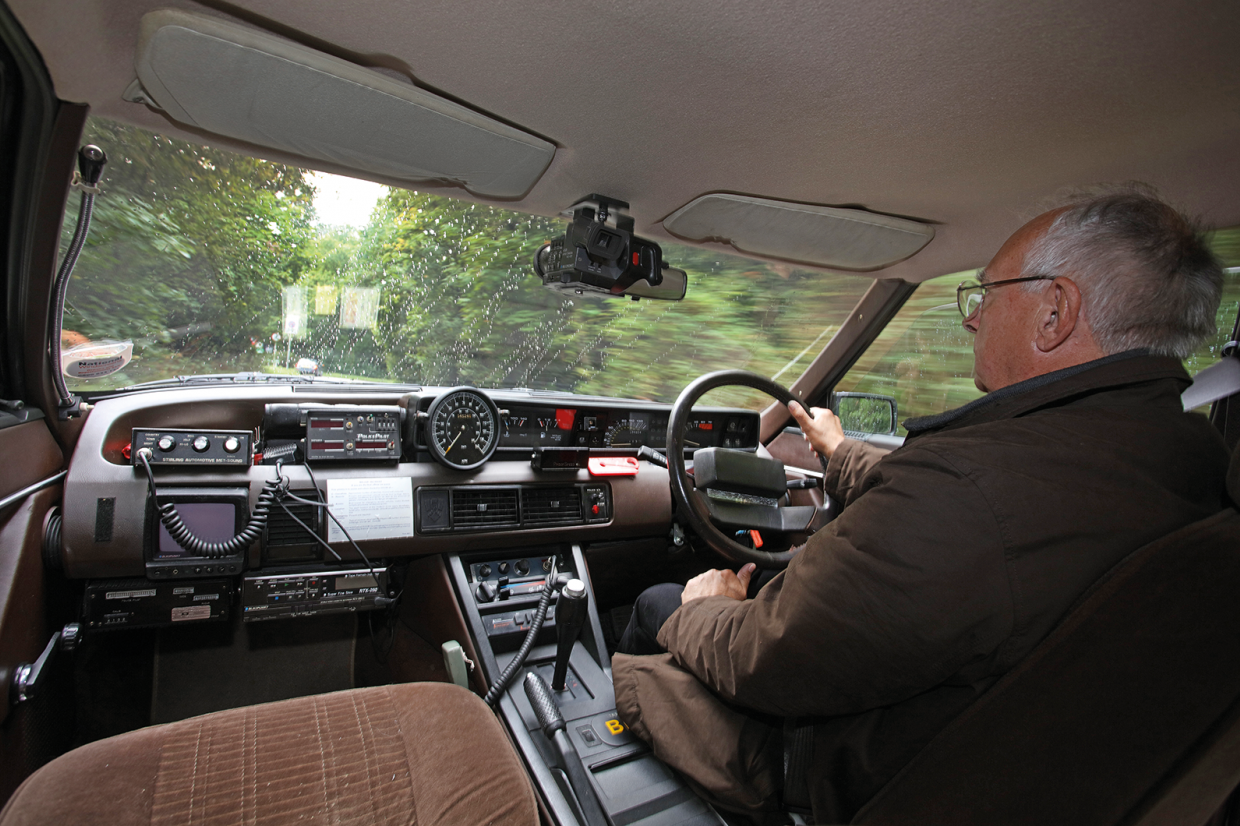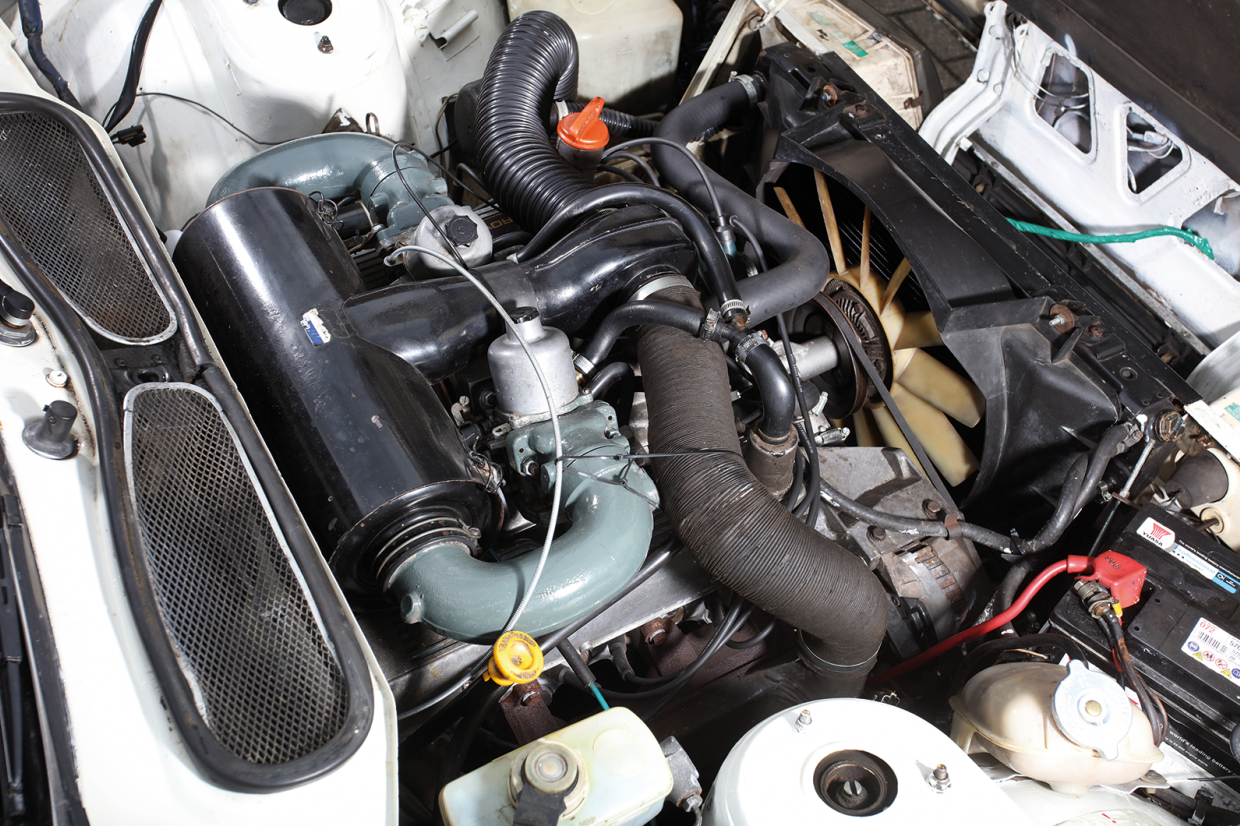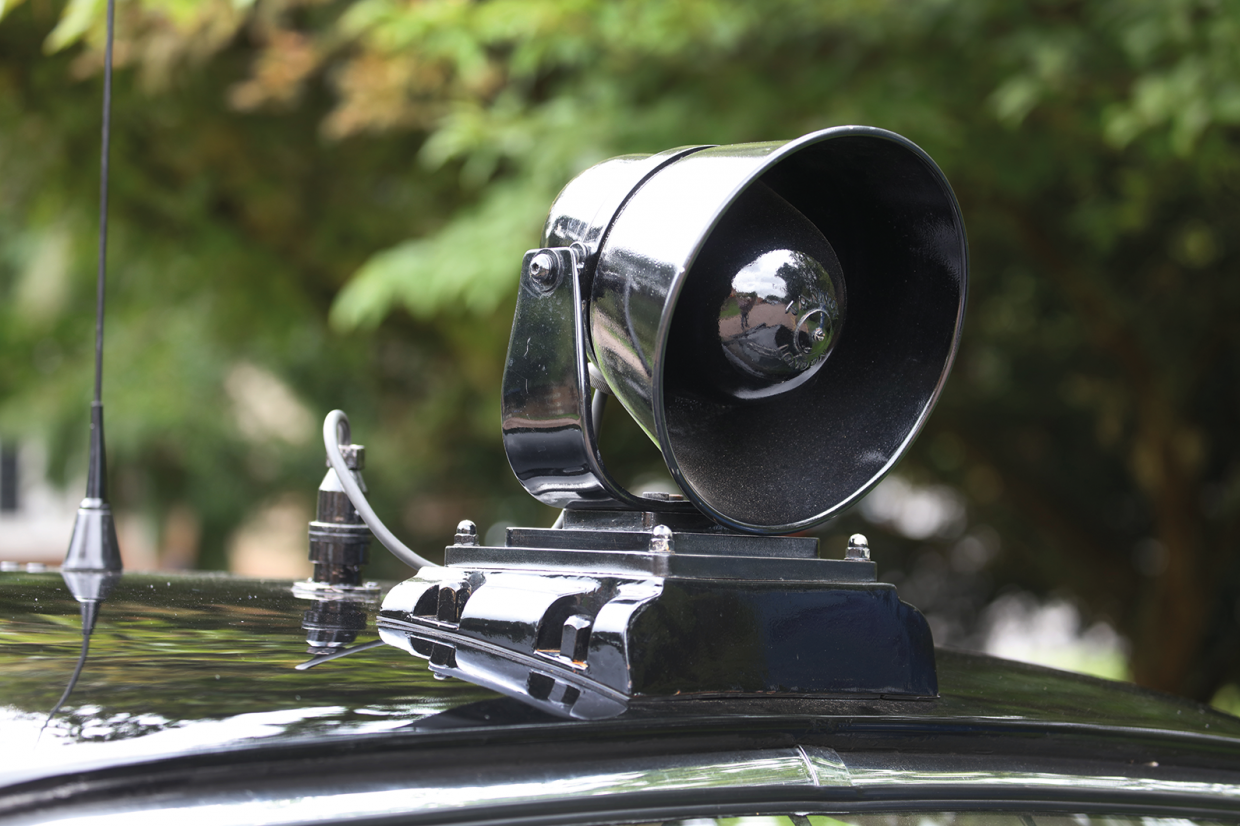Old Fashioned Police Car Thrust 7
Inside the Great britain'south finest private collection of classic police force cars

Any classic police car has a particular fascination, not just for the livery, the bespoke fittings or whatever technical modifications, but also for the way they create an image of law enforcement during a particular era.
Ernie Jupp served as an officer with the Metropolitan Police from 1970 until 1994, and his incredible collection reflects both his fourth dimension in service and the development of the patrol car in the United kingdom of great britain and northern ireland.
The oldest member of the Jupp fleet is the 1947 MG TC that he acquired in 2010.
"I discovered that it was a Warwickshire Constabulary car from Andrea Green's book MGs On Patrol," says Jupp. A great many chief constables favoured the T-blazon, including those of E Riding, Wolverhampton, Essex, Cumberland, Sussex and Derbyshire, only, says Jupp: "The forces that were well-nigh associated with the Octagon badge were Kent and Lancashire."
The TC's bell – or 'gong' as they were known in the strength – had to be sourced, but the 'loudhailer' is a cunningly bearded frying pan!
Although wider than the TB, the TC would have been a squeeze for a pair of burly cops
The TC was Abingdon'south get-go post-state of war car and, although it was 4in wider than its TB predecessor, it would have offered pretty cramped adaptation for a driver and an observer.
"With the hood up, it is not the easiest car to get into," notes Jupp, "merely lowering the roof makes all the departure."
Given the average speed of traffic in the late 1940s, a manoeuvrable sports machine that was capable of well-nigh 80mph would have been an asset to whatever force. Equally a Kent master superintendent wrote: 'The smallness of the vehicle was appreciated when tailing a lorry, considering the MG was lost to the lorry driver'due south view.'
Luxuries on the TC are few and far betwixt – "there is definitely no heater!" – but no T-blazon driver would have expected a long list of standard fittings.
"It's slap-up fun to drive, though," says Jupp, an MG enthusiast of many years standing, "but the steering is notoriously poor on pre-TD MGs." Today, the TC even so looks primed to flag downwards a cad in a Sunbeam-Talbot 90 somewhere exterior Nuneaton for 'excessive speed'.
220bhp, iii.viii-litre twin-cam 'six' gave the hefty S-type a 116mph top speed
When Jupp joined the London Metropolitan Police force, the Jaguar S-blazon was still very much in evidence. "Sadly, I never drove one at the time," he says, but he tin can now thanks to 'Charlie One', a 1968 Area Car in blackness livery (Traffic department Jaguars were painted white). Having served at West Key and, at times, Bow Street police stations until 1971, its career encompassed guarding the Blackness Maria that conveyed the Kray twins to prison in 1969.
The Met trialled three S-types in 1966, which resulted in the force ordering a large fleet – Jupp reckons 266 cars – between 1967 and the stop of production in '68.
Inside, there is a distinct lack of armrests, walnut veneer or – surprisingly – a tachometer, although the Jaguar retains its cigarette lighter.
"People sometimes remark on the 'special smell' of old police cars," smiles Jupp, "but it'south mostly nicotine!" The Borg-Warner Blazon 35 gearbox is too to police specification, with just Drive, Neutral and Contrary: "This was because, on the early Met Jaguars, the drivers would tend to overuse the low ratios."
In that location was likewise a modified rear beam, simply no power assistance for the steering: "Information technology'due south fine when you're on the movement, simply in town it can feel heavy. I in one case spoke to some former Jaguar workers, and they told me that Met-spec cars needed a special production line at Browns Lane."
P6'due south venerable Buick-derived 3.v-litre V8 gave serious footstep, with 0-60mph in 10.8 secs
Jupp discovered Charlie One well-nigh 10 years ago, when it was not in peak status: "The trunk looked tired and the gearbox was leaking oil, merely at least the roof buoy still worked."
He then began the long process of acquiring the correct Pye wireless set, the Winkworth bell – "the gong was mainly used for pulling over motorists" – and the klaxon horns. Equally for the 'Mickey Mouse' spotlamps on the roof: "They were added subsequently the Jaguar left police service by a picture show prop company."
Meanwhile, Jupp's son Nicholas painted the front end of the Jaguar and repaired the bodywork. The result is a police auto that you lot can hands imagine turning up in Carnaby Street, to cries of: "Wow, man – the Institution. What a drag."
The Rover P6 was the start large Area Machine that Jupp collection in the form of his police service; it was more usual to notice himself piloting a succession of Panda Cars: "The Morris Minor was first, and that was replaced by the Austin 1100, which was succeeded past the Allegro.
I remember those more than anything else – and, yes, they did take square steering wheels when the first batch arrived at Shooter's Hill."
Jupp'southward P6B is one of the terminal Met 3500s, entering police service in 1976 and existence stationed at Romford every bit Car K7 for about three years.
"When I bought the Rover in 2010 it looked good, simply it was in demand of attention to the floor and sills," says Jupp. "Met Rovers were painted in various shades of blue, and the special equipment included spotlamps, two-tone horns, the radio ready and the gong."
As with the Jaguar, this car has an automatic transmission – this time the Borg-Warner Blazon 65 – only no power steering. "We were used to it at that fourth dimension," says Jupp, "and as soon as yous are on the move at that place are no problems. I of the P6's real strengths is its fantastic roadholding, though the Traffic division used to complain about the lack of kicking space, and there was limited room to carry suspects in the back."
The Metropolitan Police besides used a big number of the P6B's in-house rival, the Triumph 2500 Mk2. "I collection that more than than the Rovers in the 1970s," says Jupp. "The Triumph felt more spacious, simply I thought that the 3500 had the edge because it was so wonderful to drive."
For any noncombatant old enough to recollect the belatedly 1970s, the rush of nostalgia upon seeing the Rover is virtually overwhelming – picturing greyness-faced 'hoods' with bad haircuts and worse dress sense, and the 3500 on a shout, dashing past Routemaster buses and Sherpa commitment vans.

The classic 'jam sandwich' Rover
British Leyland produced a constabulary-specification SD1 in 1976, and in that same yr the Met began to use the car that represented 'Tomorrow Today'.
"The first ones were V8-engined Surface area Cars finished in bluish," says Jupp, but by the finish of the decade it was mutual for London Rovers to be painted in white with the 'jam sandwich' stripe. The 2600 was used for area work and the 3500, with ii blue lamps, served in the Traffic divisions.
Jupp's SD1 dates from 1984, and he believes that information technology was in service in the Chadwell Heath region: "When I bought the Rover in 2012 information technology was a little tired, but since and so the paint has been refurbished and I managed to larn an off-the-shelf V8 engine that had been part of a cancelled guild."
The equipment listing includes a video camera, the old-manner calibrated speedometer, a US-style 'wailer' and an extremely heavy 'Police Accident' sign in the boot.
The Rover lacks anything in the way of luxuries that your average executive motorist would have come to expect by the mid-1980s: "The windows and door locks are transmission, every bit is the steering, but that was par for the course."


Ernie Jupp enjoys the ascetic interior and smooth thrust of the SD1 (left); replacement 3528cc V8
The SD1 was in service until effectually 1988, and on eight May 1987 this car achieved lasting fame as one of the Liver Run Rovers. A patient at Cromwell Hospital in Kensington named Aliza Hillel was rejecting her liver transplant, and another organ was found in Hull.
The liver would not survive for long outside a human trunk, just fog delayed the plane carrying it to Stansted Drome, and from there information technology would accept to exist transported past road. The London Air Ambulance would not be established until 1989, all Met helicopters were grounded because of one having suffered an engine failure, and at that place was no time to charter a private aircraft.
An Essex Police force Ford Granada took the package to Junction 7 of the M11, meeting the Rovers at xi:54am. The crews had to cover the 27 miles to Kensington before 12:30pm – crossing central London during a Friday. SD1 A738 UJD carried the liver itself, with A536 UJD serving as the back-up/photographic camera car.
The SD1s arrived at the hospital at 12:25pm and, because the officers were more used to working in outer London, the navigators used A-Z map books for part of their journey.
The Jupp Rover was decommissioned more than thirty years agone, but that was not entirely the end of its service. In 2010, it was being driven
by Sergeant Neil Roberts in a community event at RAF Northolt, when a phone call came over the radio virtually a burglary in the vicinity.
The nearest units were attending other incidents, so Roberts and the 3500 assisted in acumen the suspects – it'south non known if they thought that they were hallucinating, or appearing in an episode of Ashes to Ashes, upon sighting the Rover with blueish lights flashing.
Wolseley 6/99 is the most recent arrival to the collection
The most recent addition to the Jupp fleet, a 1960 Wolseley 6/99, arrived in March 2018.
"When Ciaran Kavanagh was restoring information technology in the late 1990s, he had to fit a bodyshell from another car because the original was so rotten," says Jupp, who is still tracing the history of the car, which sports the roof-mounted loudhailer that was used on the Traffic cars.
The cabin is trimmed to the basic standards of an entry-level Austin A99 Westminster, with a metal fascia replacing timber, and there is general lack of the 6/99's gentlemen's club atmosphere.
Jupp was surprised by the Wolseley's road manners on its radial-ply tyres: "I had expected it to be much worse. I don't similar to throw her around, of course, but the steering feels lighter than the Jaguar and the two Rovers."


Wolseley (left) and MG are both amongst Jupp's drove, but the Wolseley is our option
Naturally, Jupp has no favourites among his collection, merely we have no demand to exist impartial. A Wolseley half dozen/99 police car is one of the most of import cars in the history of the automobile in the Great britain, and is inextricably linked to post-state of war British pop culture.
With such a vehicle, who could resist the temptation to issue orders through the tannoy as in Quatermass and the Pit, or to sound the gong, reviving memories of The Fast Lady. And that C-serial engine note was as essential to an Edgar Wallace thriller as the theme melody.
We had to get out the Wolseley until final because, afterwards experiencing the 6/99, the remainder were always going to exist an bathos…
Images: James Isle of mann; thank you to The Warren Metropolitan Law Sports Club and Law Machine Great britain
READ MORE
Who says estate cars aren't sexy?
Brilliant '60s classics for every budget
Why the Jaguar XJ is the globe'south all-time saloon car


0 Response to "Old Fashioned Police Car Thrust 7"
Post a Comment